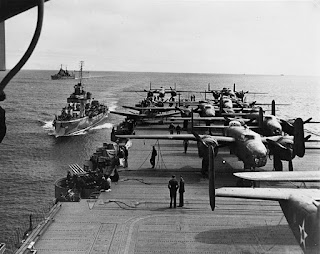 |
| William “Billy” Mitchell |
After the war, he headed the Aviation of the Army of Occupation, established in Germany. When he returned from Europe, having led air forces in combat and served as an Allied air commander, he was appointed Assistant Chief of the Air Service.
Mitchell's major premise was airpower, organized into a separate, equal (to Army and Navy) and an autonomous air force under a unified department of defence, could serve as the most effective an economical means of defending the continental U.S.
Also Read:
Effect: Mitchell’s theories on airpower have had a profound and lasting effect on airpower doctrine and the employment of airpower. He is often referred to as the “father of the modern Air Force.” The major premise of his theories was his belief that an independent and equal air force serving under a unified department of defense was the most efficient means of defending the United States.
 |
| Doolittle Raid 1942 Source: Wikimedia/National Museum of the USAF |
William “Billy” Mitchell, more than any other individual was responsible for molding the airpower convictions that served as the doctrinal basis of the United States Air Force. As World War One came to a close, Mitchell argued to preserve the aviation expertise gained during the war, both in terms of personnel and equipment. Through prolific writing and speaking, Mitchell carried the airpower case—the case of an independent air force—to the American public. Mitchell’s most lasting contribution was moving the idea of air force autonomy to a progressive view, which held that independent air operations could achieve strategic results rather than simply being chained to the support of armies and navies. Mitchell’s ideas and goals were adopted and shared by a wide following of early air officers, including “Hap” Arnold and “Tooey” Spaatz. Through Mitchell’s advocacy, the concepts of the offensive nature of airpower, the importance of air superiority, the primacy of strategic bombing, and the value of interdiction over close air support became enduring beliefs of modern airpower.
Mitchell’s Legacy
Mitchell’s Legacy
- Influenced the development of U.S. airpower doctrine
- Elevated the concept of independent air forces
- Originated ideas and goals shared by a wide following of early air officers
- Advanced the airpower concepts of:
➤Offensive nature of airpower
➤Importance of air superiority
➤Primacy of strategic bombing
➤Value of interdiction over close air support
- Joined Army Air Force as a Signal Corps Officer
- Attended flight training at his own expense
- Appointed to the General Staff
- First American airman to command air forces in WWI
- Appointed Assistant Chief of the Air Services
- Became the voice of independent airpower
- Provoked court-martial in 1925
- Major Assumptions
- Thoughts on Targeting
- Thoughts on Air Superiority
- Thoughts on Air Exploitation
- The advent of aviation was revolutionary in military affairs.
- Command of the air is a prime requirement.
- Airpower is inherently offensive; the bomber will always get through.
- Anti-aircraft artillery is ineffective.
- Airpower can defend the Continental U.S. more economically than the Navy. Naval warfare is obsolete.
- Airmen are a special and elite breed of people, and they alone can understand the proper employment of airpower.
- Future wars will be total; the ascendancy of the ground defensive will persist; everyone is a combatant.
- Civilian morale is a fragile thing.
Mitchell favored breaking civilian morale through the destruction of vital centers, like industry, infrastructure, and even agriculture. Mitchell’s intellectual heirs at the Air Corps Tactical School refined and synthesized his ideas by using the industrial triangle of the U.S. as the model for the development of precision bombing theory and doctrine.
Thoughts on Air Superiority:
 Mitchell believed that air superiority was a prerequisite for all other military operations. He argued that this would be achieved largely by air battles; however, attacks on enemy airpower on the ground were also in his repertoire. He disdained the effectiveness of anti-aircraft artillery. Interestingly, Mitchell’s doctrinal descendants at the Air Corps Tactical School in the 1930’s may have tended to downplay the achievement of air superiority thorough air battles, which many say led to a neglect of pursuit and attack aviation in favor of strategic bombing
Mitchell believed that air superiority was a prerequisite for all other military operations. He argued that this would be achieved largely by air battles; however, attacks on enemy airpower on the ground were also in his repertoire. He disdained the effectiveness of anti-aircraft artillery. Interestingly, Mitchell’s doctrinal descendants at the Air Corps Tactical School in the 1930’s may have tended to downplay the achievement of air superiority thorough air battles, which many say led to a neglect of pursuit and attack aviation in favor of strategic bombingThoughts on Air Exploitation:
Once air superiority is established, it can be exploited at will in varied operations against vital centers. Sometimes vaguely described, vital centers were usually seen as an industry, infrastructure, and agriculture which, when destroyed, would lead to the collapse of civilian morale.
Implications of Mitchell’s Theories:
Implications of Mitchell’s Theories:
- Organization for War
- Role of Other Armed Forces
- Force Structure
- Technology Requirements
Mitchell argued for a separate and equal, but independent, air force and for a unified department of defense.
Roles of Other Armed Forces:
Roles of Other Armed Forces:
The Air Force would be the primary force in warfare, with the navy playing a secondary role, and there would be an even lesser role for the army. The defeat of the enemy’s army and navy is a false objective; the true objective is the will of the enemy, which can be reached without defeating enemy surface forces.
Force Structure:
Force Structure:
Mitchell, at first, advocated a preponderance of pursuit units, but then increasingly emphasized the need for more bomber units.
Technology Requirements:
Technology Requirements:
No single type of plane was adequate; pursuit aircraft for command of the air was a paramount requirement, and at least in the early 1920s, he stipulated a need for both attack and reconnaissance aircraft. His supporters in the Air Corps Tactical School (and much of the rest of the air arm of the 1930s) were persuaded that technology had arrived to validate Mitchell’s theories. High-altitude bombers with bomb-sight targeting systems would make the bomber a decisive weapon system that would be difficult to counter by enemy defensive systems.
Key Aspects of Mitchell’s Theories:
Airpower, organized into a separate, equal (to Army and Navy) and autonomous air force under a unified department of defense, could serve as the most effective and economical means of defending the continental U.S. Even if it came to fighting an overseas enemy, airpower could decisively attack enemy vital centers without first defeating enemy armies and navies. Airpower is best generated by nations with populations that are “fair-minded,” and the U.S. has great potential but it needs to be developed.
Mitchell favored breaking civilian morale through the destruction of vital centers, like industry, infrastructure, and even agriculture. Mitchell’s intellectual heirs at the Air Corps Tactical School refined and synthesized his ideas by using the industrial triangle of the U.S. as the model for the development of precision bombing theory and doctrine.
Mitchell believed that air superiority was a prerequisite for all other military operations. He argued that this would be achieved largely by air battles; however, attacks on enemy airpower on the ground were also in his repertoire. He disdained the effectiveness of anti-aircraft artillery. Interestingly, Mitchell’s doctrinal descendants at the Air Corps Tactical School in the 1930’s may have tended to downplay the achievement of air superiority thorough air battles, which many say led to a neglect of pursuit and attack aviation in favor of strategic bombing.
Key Aspects of Mitchell’s Theories:
Airpower, organized into a separate, equal (to Army and Navy) and autonomous air force under a unified department of defense, could serve as the most effective and economical means of defending the continental U.S. Even if it came to fighting an overseas enemy, airpower could decisively attack enemy vital centers without first defeating enemy armies and navies. Airpower is best generated by nations with populations that are “fair-minded,” and the U.S. has great potential but it needs to be developed.
Mitchell favored breaking civilian morale through the destruction of vital centers, like industry, infrastructure, and even agriculture. Mitchell’s intellectual heirs at the Air Corps Tactical School refined and synthesized his ideas by using the industrial triangle of the U.S. as the model for the development of precision bombing theory and doctrine.
Mitchell believed that air superiority was a prerequisite for all other military operations. He argued that this would be achieved largely by air battles; however, attacks on enemy airpower on the ground were also in his repertoire. He disdained the effectiveness of anti-aircraft artillery. Interestingly, Mitchell’s doctrinal descendants at the Air Corps Tactical School in the 1930’s may have tended to downplay the achievement of air superiority thorough air battles, which many say led to a neglect of pursuit and attack aviation in favor of strategic bombing.

Once air superiority is established, it can be exploited at will in varied operations against vital centers. Sometimes vaguely described, vital centers were usually seen as an industry, infrastructure, and agriculture which, when destroyed, would lead to the collapse of civilian morale.
Mitchell argued for a separate and equal, but independent, air force and for a unified department of defense.
The Air Force would be the primary force in warfare, with the navy playing a secondary role, and there would be an even lesser role for the army. The defeat of the enemy’s army and navy is a false objective; the true objective is the will of the enemy, which can be reached without defeating enemy surface forces.
Mitchell, at first, advocated a preponderance of pursuit units, but then increasingly emphasized the need for more bomber units.
No single type of airplane was adequate; pursuit aircraft for command of the air was a paramount requirement, and at least in the early 1920s, he stipulated a need for both attack and reconnaissance aircraft. His supporters in the Air Corps Tactical School (and much of the rest of the air arm of the 1930s) were persuaded that technology had arrived to validate Mitchell’s theories. High-altitude bombers with bomb-sight targeting systems would make the bomber a decisive weapon system that would be difficult to counter by enemy defensive systems.
Influence on U.S. Military Aviation:
Mitchell advocated a national system of airways and airports to further aeronautics within America. He felt that aviation of all types (general, commercial, and military) served the security interests of the country. Mitchell realized that aviation asset could be used in peacetime as well as in war.
Mitchell fought for Air Corps support from Congress and industry. Mitchell repeatedly lobbied Congress for funds to equip the Air Corps with personnel and equipment that were adequate for developing an air force. His intense efforts kept aeronautics alive within the Army and across America. He petitioned the emerging aviation industry to produce better and more reliable aircraft and engines. He angrily railed against manufacturers that produced shoddy and inferior equipment that killed airmen and wrecked aircraft. His efforts helped root out corruption within the industry and brought to light the inadequate aircraft and engines being developed in America.
He helped commit the US to security through airpower, as the voice of airpower and the catalyst for aeronautics programs. The body of thought he is associated with was widely shared within the small corporate body of the Air Service, and his flamboyant style brought them to public attention. Some authors say he helped condition American opinion so that ultimately the US would commit to strategic bombing. Mitchell articulated the idea of “airmindedness.”
Despite Mitchell’s urgings following WWI, his voracious efforts to inspire a national aeronautics program, and his outspoken criticisms of national airpower capabilities, the United States remained woefully behind other developed nations in developing air forces. It took the looming Second World War to motivate the aviation community toward the goals Mitchell had urged a few short decades earlier. Had it not been for Mitchell, it is likely that United States aeronautics would have been even more outdated on the eve of WW II.
Influence on the U.S. Air Force
There can be little doubt that Mitchell had an enormous influence on the foundation and the development of the USAF. Though Doolittle and others have argued that he did more harm than good, Mitchell’s vision was largely fulfilled in the long term. Many of Mitchell’s friends and supporters in the Air Corps gained prominence and continued to shape air forces in line with his views. Hap Arnold, who took charge of the Air Corps in 1938, was one of Mitchell’s supporters. Arnold remained in office for seven formative years just before and during WWII, during which time the strategic bombing theory, in large part, dominated the way the Army Air Force fought the war.
Arnold’s most trusted agent, Carl Spaatz, who was a close friend of Mitchell, succeeded Arnold as the first Chief of Staff of the Air Force. Spaatz was important because he was at the helm when the initial institutions of the USAF were articulated. Many of Spaatz’s ideas on air power reflected ideas that had been articulated by Mitchell.
Influence on the U.S. Navy:
It has often been argued that if Mitchell had not existed, then the United States Navy would have had to invent him. Mitchell offered proponents of naval aviation a way to persuade their conservative senior officers and colleagues that if they did not take the initiative, Mitchell would take their airpower away from them.
Influence on World War II:
Mitchell strongly believed that airpower must be under the command of an airman. Early in the war effort, airpower was parcelled out underground commanders and the result was disastrous. As airmen asserted their belief that airmen must command airpower, the effectiveness of the air effort increased dramatically. General Kenney’s air force in the Pacific was an excellent example of Mitchell’s views.
Mitchell’s ideas had a great impact on the Army Air Forces approach to war. One of those ideas, that airpower would engage the enemy long before armies gained contact, was implemented by the 8th Air Force, the first large unit deployed to England. It was made up of both strategic bombers and fighters and participated in an air war against Germany for two years before the armies landed at Normandy.
At least implied in the Mitchell and the Air Corps Tactical School concepts was the notion that navigation and bombing accuracy would be sufficient to be decisive in a short time. This proved disappointing during the war. In addition to the bombing being less effective than Mitchell had anticipated, advances in air defence, especially in Germany, proved much more effective than Mitchell predicted based on his experiences in World War One.
As for his ideas on maritime warfare, some were more accurate during the war years than others. Although airpower had ushered in the end of the age of the battleship, navies continued to play a vital role in warfare. Aircraft carriers had become the capital ships and battleships served in support as anti-aircraft artillery platforms and amphibious artillery support vessels.
Although airpower was not as decisive as Mitchell had envisioned, it was also not employed as Mitchell had envisioned. Many of Mitchell’s beliefs in the decisive nature of airpower would not be proven for several decades until technology had matured and airmen were allowed to employ airpower consistent with Mitchell’s earlier vision
Mitchell strongly believed that airpower must be under the command of an airman. Early in the war effort, airpower was parcelled out underground commanders and the result was disastrous. As airmen asserted their belief that airmen must command airpower, the effectiveness of the air effort increased dramatically. General Kenney’s air force in the Pacific was an excellent example of Mitchell’s views.
 |
| The bombing of Hanover (Germany) |
At least implied in the Mitchell and the Air Corps Tactical School concepts was the notion that navigation and bombing accuracy would be sufficient to be decisive in a short time. This proved disappointing during the war. In addition to the bombing being less effective than Mitchell had anticipated, advances in air defence, especially in Germany, proved much more effective than Mitchell predicted based on his experiences in World War One.
As for his ideas on maritime warfare, some were more accurate during the war years than others. Although airpower had ushered in the end of the age of the battleship, navies continued to play a vital role in warfare. Aircraft carriers had become the capital ships and battleships served in support as anti-aircraft artillery platforms and amphibious artillery support vessels.
Although airpower was not as decisive as Mitchell had envisioned, it was also not employed as Mitchell had envisioned. Many of Mitchell’s beliefs in the decisive nature of airpower would not be proven for several decades until technology had matured and airmen were allowed to employ airpower consistent with Mitchell’s earlier vision







.jpg)
